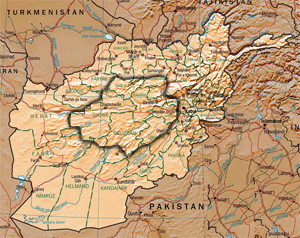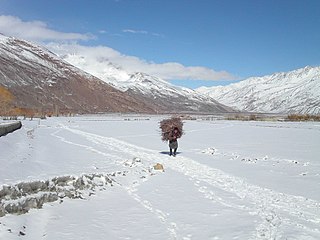 W
WBadakhshan is a historic region comprising parts of what is now northeastern Afghanistan, eastern Tajikistan, and the Tashkurgan county in China. The name is retained in Badakhshan Province, which is one of the 34 provinces of Afghanistan and is located in Northeastern Afghanistan. Much of historic Badakhshan lies within Tajikistan's Gorno-Badakhshan Autonomous Region, located in the southeastern part of the country. The music of Badakhshan is an important part of the region's cultural heritage.
 W
WBalochistan is an arid desert and mountainous region in south-western Asia. It comprises the Pakistani province of Balochistan, the Iranian province of Sistan and Baluchestan, and the southern areas of Afghanistan, including Nimruz, Helmand and Kandahar provinces. Balochistan borders the Pashtunistan region to the north, Sindh and Punjab to the east, and Persian regions to the west. South of its southern coastline, including the Makran Coast, are the Arabian Sea and the Gulf of Oman.
 W
WBalochistan(Balochi: بلوچستان) or Baluchistan is an arid, mountainous region that includes part of southern and southwestern Afghanistan. It extends into southeastern Iran and western Pakistan and is named after the Baloch people.
 W
WKhorāsān, sometimes called Greater Khorasan, is a historical region which formed the northeast province of Greater Iran. The name signifies "the Land of the Sun" or "the Eastern Province".
 W
WHazārajāt or Hazāristān (هزارستان) is a mountainous region in the central highlands of Afghanistan, among the Koh-i-Baba mountains in the western extremities of the Hindu Kush. It is the homeland of the Hazara people who make up the majority of its population. "Hazārajāt denotes an ethnic and religious zone." Hazarajat is primarily made up of the provinces of Bamyan, Daykundi, Ghor and parts of Ghazni, Urozgan and Maidan Wardak. The most populous towns in Hazarajat are Bamyan, Yakawlang (Bamyan), Nili (Daykundi), Lal wa Sarjangal (Ghor), Sang-e-Masha (Ghazni), Gizab (Urozgan) and Behsud. The Kabul, Farah, Hari, Murghab, Balkh and Kunduz rivers originate from Hazarajat.
 W
WLōya Paktiā is a historical and cultural region of Afghanistan, comprising the modern Afghan provinces of Khost, Paktia, and Paktika, as well as parts of Logar and Ghazni, and parts of Kurram and Waziristan in Pakistan. Loya Paktia is vaguely defined by a common culture and history that is connected to the local indigenous tribes that reside in the region. Particular styles of clothing, articles of clothing, turban styles, turban cloth colors, dialects of Pashto language, etc. may sometimes be associated with specific tribes indigenous to Loya Paktia and thus integrate themselves into regional culture. For instance, a Pashtun tribesman from Loy Kandahar may quickly recognize a Pashtun from Loya Paktia based upon his turban style and color. Likewise, a Pashtun from Loya Paktia may recognize someone from Loy Kandahar based upon his unique style of collarless kameez (shirt) with specific embroidered patterns on the front. There are many subtle and intricate cultural indicators of this type that are not recorded in any known written history but simply known and observed by the tribesmen of the various Pashtun regions of Afghanistan and Pakistan.
 W
WPashtūnistān is the geographic historical region inhabited by the indigenous Pashtun people of modern-day Afghanistan and Pakistan in South-Central Asia, wherein Pashtun culture, language, and national identity have been based. Alternative names historically used for the region include "Pashtūnkhwā" (پښتونخوا) and "Afghānistān" (افغانستان), since at least the 3rd century CE onward. Pashtunistan borders Iran to the west, Persian and Turkic-speaking areas of Turkestan region to the north, Kashmir to the northeast, Punjab to the east, and Balochistan to the south.
 W
WThe Sistan Basin is an inland endorheic basin encompassing large parts of southwestern Afghanistan and minor parts of southeastern Iran, one of the driest regions in the world and an area subjected to prolonged droughts. Its watershed is a system of rivers flowing from the highlands of Afghanistan into freshwater lakes and marshes and then to its ultimate destination: Afghanistan's saline Godzareh depression, part of the extensive Sistan terminal basin. The Helmand River drains the basin's largest watershed, fed mainly by snowmelt from the mountains of Hindu Kush, but other rivers contribute also.
 W
WWakhan or "the Wakhan" is a rugged, mountainous part of the Pamir, Hindu Kush and Karakoram regions of Afghanistan. Wakhan District is a district in Badakshan Province.